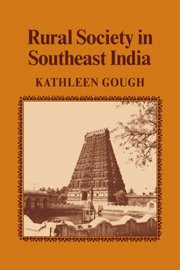Book contents
- Frontmatter
- Contents
- Preface
- Part I Thanjāvūr
- 1 The District
- 2 Castes and Religious Groups
- 3 The Agriculturalists
- 4 The Nonagriculturalists
- 5 Variations in Ecology, Demography, and Social Structure
- 6 The Colonial Background and the Sources of Poverty
- 7 Political Parties
- Part II Kumbapeṭṭai
- Part III Kirippūr
- Notes
- Glossary
- Bibliography
- Index
- CAMBRIDGE STUDIES IN SOCIAL ANTHROPOLOGY
5 - Variations in Ecology, Demography, and Social Structure
from Part I - Thanjāvūr
Published online by Cambridge University Press: 29 October 2009
- Frontmatter
- Contents
- Preface
- Part I Thanjāvūr
- 1 The District
- 2 Castes and Religious Groups
- 3 The Agriculturalists
- 4 The Nonagriculturalists
- 5 Variations in Ecology, Demography, and Social Structure
- 6 The Colonial Background and the Sources of Poverty
- 7 Political Parties
- Part II Kumbapeṭṭai
- Part III Kirippūr
- Notes
- Glossary
- Bibliography
- Index
- CAMBRIDGE STUDIES IN SOCIAL ANTHROPOLOGY
Summary
Both within Thanjāvūr and within Tamiḷ Nāḍu there are wide variations in ecology, demography, agrarian relations, and the distribution of castes. In this chapter I explore these differences and attempt to explain the relations among certain major variables, making use of statistical correlations. My data are chiefly derived from the Censuses of India of 1951, 1961, and 1971. Although my interpretations for 1961 and 1971 to some extent encroach on my discussion in Volume II of this work, the data for those decades sufficiently resemble those for 1951 to be discussed here rather than in Volume II.
I began this investigation with the following arguments and hypotheses. Leaving aside the Nilgiris district with its mountainous terrain and relatively cold climate, it was hypothesized that the other areas of Tamiḷ Nāḍu practiced intensive paddy cultivation in those regions where heavier rainfall made this favorable. Millets and other grain crops, by contrast, were thought to be grown mainly on dryer lands. Paddy cultivation provides more calories per acre than do millets; it was therefore hypothesized that it would be found with denser populations. The areas of higher rainfall, more paddy cultivation, and greater density were hypothesized to possess more pronounced social stratification; from observation and history, it was thought that these areas were initially the ones that gave rise to the state. Once states arose, in the centuries preceding the Christian era, their governments used their coercive powers to build large-scale irrigation works and to foster a more intensive development of local irrigation.
- Type
- Chapter
- Information
- Rural Society in Southeast India , pp. 67 - 104Publisher: Cambridge University PressPrint publication year: 1982



